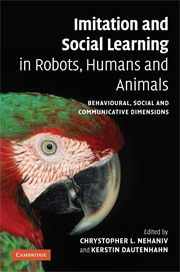 Imitation and Social Learning in Robots, Humans and Animals
Imitation and Social Learning in Robots, Humans and Animals Published online by Cambridge University Press: 10 December 2009
Introduction
Overview
This chapter proposes a possible connection between bullying behaviour, empathy and imitation. The primary aim of our work is to provide a clearer understanding of bullying behaviour, by focusing on cognitive and emotional states that might cause bullies to show anti-social behaviour. We begin by providing a review of relevant research about bullying behaviour including definitions of bullying behaviour, the behavioural characteristics of bullies and victims, precursors of bullying behaviour and several ideas about how bullies become bullies. This is followed by a discussion of empathy and imitation where two contrasting case studies of autism and psychopathy are given to illustrate differences in imitation and empathic skills and deficits. Finally, we try to bring together these different lines of research and present the hypothesis that bullies possess well-developed automatic as well as cognitive empathy, and that bullying behaviour is caused by an overemphasis of goal-directed processes of controlled empathy that work towards non-empathy. The importance of gaining a deeper understanding of empathic and imitation skills/deficits for different bullying roles is highlighted and discussed in relation to implications for anti-bullying intervention initiatives, where empathy and imitative interactive behaviour can be integrated.
What is bullying?
The pervasive nature and deleterious consequences of bullying and victimization behaviour has generated a great deal of research interest over the past decade. Bullying behaviour is distinguishable from aggressive behaviour per se as it has to be a repeated action that occurs regularly over time (Olweus, 1999), and it usually involves an imbalance in strength, either real or perceived (Whitney and Smith, 1993).
To save this book to your Kindle, first ensure no-reply@cambridge.org is added to your Approved Personal Document E-mail List under your Personal Document Settings on the Manage Your Content and Devices page of your Amazon account. Then enter the ‘name’ part of your Kindle email address below. Find out more about saving to your Kindle.
Note you can select to save to either the @free.kindle.com or @kindle.com variations. ‘@free.kindle.com’ emails are free but can only be saved to your device when it is connected to wi-fi. ‘@kindle.com’ emails can be delivered even when you are not connected to wi-fi, but note that service fees apply.
Find out more about the Kindle Personal Document Service.
To save content items to your account, please confirm that you agree to abide by our usage policies. If this is the first time you use this feature, you will be asked to authorise Cambridge Core to connect with your account. Find out more about saving content to Dropbox.
To save content items to your account, please confirm that you agree to abide by our usage policies. If this is the first time you use this feature, you will be asked to authorise Cambridge Core to connect with your account. Find out more about saving content to Google Drive.